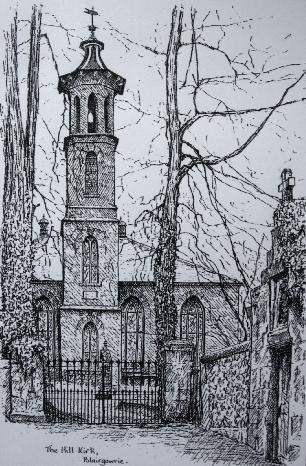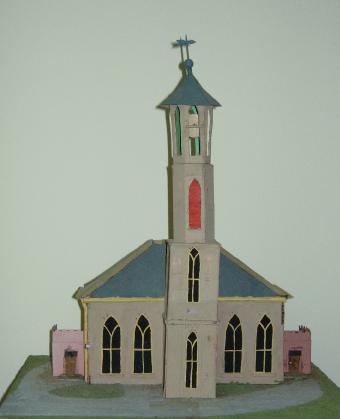 | ||||||||||||||||||||||||
LOCAL CHURCHES THE HILL CHURCH | ||||||||||||||||||||||||
Parish Church The original Parish Church of Blairgowrie, latterly known as the Hill Church, was built alongside the main thoroughfare of Blairgowrie long before the bridge over the River Ericht was built. Behind the church was the village green, and along the braeside were the cotter houses of the villagers, dotted here and there with small crofts. The site of the church was nearly equidistant from both the northern and southern extremities of the parish and was quite accessible to the majority of the inhabitants. It stood a few yards south from where the present church stands, across the path that leads from the main gate. The foundation of a church following in Blairgowrie goes back to the time of St Columba and his followers. There was a small Columban monastic institution here in the 7th and 8th centuries run by monks who were doctors and teachers as well as preachers. It is recorded that in 1201 an agreement was entered into between the church of Blairgowrie and the monks of Coupar Angus that the monks would pay the church a stone of wax for the lighting of their church yearly at Martinmass, thus confirming that there was a church in Blairgowrie at that time. Other records state that on 6th May 1207 the church called the church of Blair in Gowrie was confirmed to Cambuskenneth Abbey near Stirling by a Papal Bull from Pope Innocent III. In 1215 William, Bishop of St Andrews, ordained 100 shillings to be taken from the church, payable by the parson, and given to the Abbot and Canons of Cambuskenneth so that masses might be said for charity and the soul of William the Lion. On September 13th 1243 the church was dedicated by David de Bernham, the Bishop of St Andrews, but there is no record of why it took so long to be consecrated. In 1329 the incumbent of the church was Thomas de Sancto Claro. He was succeeded by Malcolm de Donirdi, then Richard de Roxborch. From 1345 to 1350 Ingram de Kettenis served here. He was an important man, secretary to Queen Joan, wife of David II (Robert the Bruce's son) who was the first king of Scotland to be anointed with sacred oil as part of the crowning ceremony in Scone Abbey. | ||||||||||||||||||||||||
 | ||||||||||||||||||||||||
Artwork by Mary McGregor | ||||||||||||||||||||||||
When John Lyell, the rector of Blairgowrie, followed in 1356 the Bishop of St Andrews ordained that, when John Lyell died or demitted office, the living of Blairgowrie should go to the Abbot and monks of the Augustinian Abbey in Scone. This church was to be served by a vicar pensioner, while the pension to Cambuskenneth was to continue. Scone Abbey had the oversight of eleven churches in the area, including Blairgowrie. Scone Abbey was burned to the ground in 1559, just before the Reformation of the following year. From about 1569 to 1574 Thomas Cruickshanks, canon of Scone, had a number of churches in his care, including Blairgowrie. James Hepburn, also a canon of Scone, was here for a short time. After his death in 1576 Andrew Moncur, a monk from Coupar Angus, came as reader. In 1586 William Rattray from Little Blair was reader here. He was followed in 1588 by Thomas Cruickshanks, ex- monk of Scone Abbey. He is assumed to be the last priest and first protestant minister of the Parish Church. John Ross, who was a Cameronian, came in 1603. He provided some stability as he ministered here for the next 40 years. During his incumbency, in 1610, King James VI and I restored Episcopacy in Scotland. John Ross was a man of outstanding character. He is well known for his persuasive tactics in a game of shinty: he always missed the ball but hit the shins of the young men of Blairgowrie who preferred to play shinty rather than attend church on a Sunday. He was followed by John Ramsay, then by Thomas Blaire from Ardblair who went to Bendochy in 1668. That same year saw the arrival of Gilbert Blaire, a Jacobite. In July 1689 Episcopacy was disestablished as the form of church government of the Church of Scotland and its property was handed over to the Presbyterians, but Gilbert Blaire manage to hold on unofficially to the parish Church until 1701. He was the last Episcopal minister of the church and when he left he set up a meeting house elsewhere in the town for Episcopalians. It was destroyed in 1746. Services were held in various other houses until 1773 when the congregation dissolved after the death of the then minister, James Hill. In 1702 William Stewart came as the first Presbyterian minister to the Parish Church. He was followed by James Lyon during whose ministry, in 1767, a new church was built on the present site, which had been part of the burial ground. William Dow followed. He had been previously a schoolmaster here. During his incumbency, in 1771, the manse was built. James Johnstone was ordained in 1787. During his ministry, in 1798, a collection was taken so that Peter Forbes, the schoolmaster, might start a Sunday School in the parish, the first of its kind. A Parish Church Sabbath School Picnic flag survives to this day, age unknown. An increase in population due to the introduction of the mills meant a larger church was needed. This resulted in the third and present church being built in 1824. On Monday 31st May 1824, the day the foundation stone was laid, there was a great Masonic pageant, with about 250 people marching through the street, including those from Rattray, as a compliment for granting the use of their church to the people of Blairgowrie during the building of the Blairgowrie church. William Macpherson Esq., Laird of Blairgowrie, laid the foundation stone. A cavity in the stone contained a number of items including census returns of the district for 1821, and masonic papers. The foundations of the east, south and west walls were the same as the previous church, but the site was extended to the north to make a larger building. The site covered the old 'mercat gate'. The Rev. Robert Macdonald came in 1837. The new church was found to be too small for the still growing population. As the chapel belonging to the Burgher congregation in Brown Street was for sale it was decide to purchase the building and open it as a Chapel of Ease or Preaching Station, under the superintendence of the parish Church minister. In 1838 most of the manse was taken down and rebuilt and several rooms were added. In 1843, when the Disruption took place, the Rev. Robert Macdonald left the Parish Church along withn nearly all the congregation, to join with the newly formed Free Church. The Rev. Archibald Ochiltree Greig, who was the minister in the Brown Street Chapel at the time, stayed loyal to the Established Church and moved back with his congregation to the parish Church. He had been minister in Brown Street since 1839 and continued as the Parish minister until 1852. During the incumbency of the next minister, Rev. William Fraser, the Parish Church became overcrowded once more and in 1870 it was decided to reopen the Brown Street Chapel as a place of worship for the overspill. The minister there would still be under the superintendence of the Parish Church minister, as before. This practice continued for another nine years until, in 1879, the chapel became a 'Quod Sacra' church in its own right. Robert Kemp, the next minister, came in 1881. He was known as a poet, having a book of verse published in 1882. During his 34 years of ministry the interior of the church was re-seated, a new front was put on the gallery, a new pulpit was erected and a Session House was built, the foundation stone being laid on 8th May with Masonic honours. A sealed bottle containing papers and coins was placed in a cavity in the foundation stone. The hall was formally opened on 15th September 1902. It cost about £1060. In November 1913 a new organ was introduced. Some of the parts from the old organ were used in the construction of the new organ in the Methodist Church. Rev. Kemp died in 1915. The Rev. Joseph Edwards Richers, who was a native of Durham, followed. He had spent eleven year as a minister with the Congregational Church, first in Grimsby then in Sidcup, Kent, before being admitted to the Church of Scotland in 1915. He was inducted in Blairgowrie in January 1916. In 1920 a stained glass window was unveiled to the memory of the members of the congregation who fell in the war. In 1934 the minister was presented with a new pulpit gown and cassock by members of the Girls Association. The presentation was unique; it is understood to be the first time that a young people's society in Scotland had gifted robes to their minister. In 1938 the church hall was reopened after being closed for enlargement and improvement. In 1939 a stained glass window was installed and dedicated in the church. Both window and hall improvements were the gift of Mr. James Duff of Glenericht, as a thank-offering on reaching his 90th year. Mr. Richers researched the history and traditions of Blairgowrie and gave many talks on 'Old Blair'. He demitted office on Remembrance day in 1948. The last minister of the church was Rev. Alexander Foubister Taylor Young who was inducted on 23rd June 1949. He spent most of his youth in Alloa and had been minister in Castle Douglas before coming to Blairgowrie. He ministered here for twenty-seven years before taking retirement in 1976 'in the interests of readjustment'. There was no special service to mark the closure of the church. The final service took place on Sunday 27th June, and the Hill Church was dissolved a few days later, on 30th June 1976. The congregation dispersed to the various churches in the area. The Presbytery agreed to gift the furniture of the church and the stained glass windows to various places outwith Blairgowrie. The communion ware was gifted to Edzell-Lethnot Parish Church. In 1978 parts of the Hill organ were incorporated in the rebuilding of the Alyth Parish Church organ after it was damaged by fire. The war memorials, along with the pulpit bible presented to Rev. Richers, were displayed in St Mary's-South Church until it closed in 2002. They are now in the present day Blairgowrie Parish Church in James Street. | ||||||||||||||||||||||||
 | ||||||||||||||||||||||||
In 1977 the church hall at the foot of Kirk Wynd was sold to the Order of the Eastern Star who had it for a few years. It is now occupied by the Evangelical Church. The Hill manse which had been empty for a number of years was burned to the ground by the developers in January 1989 to make way for the houses of Manse Court which now stand there. Rev. Taylor Young died in August of that year. The church was bought in 1979 by the Blairgowrie Players who still occupy the building. It can be seen lit up at night on top of the hill overlooking the town.
The cardboard model on the right was constructed by Colin Farquharson in about 1977 when he was in Hill Primary 6 or 7. We believe Colin now lives in Canada and works as a geophysicist. | ||||||||||||||||||||||||
For further information about churches in the area, see the Social History of Blairgowrie and Rattray. Details on the Publications page | ||||||||||||||||||||||||